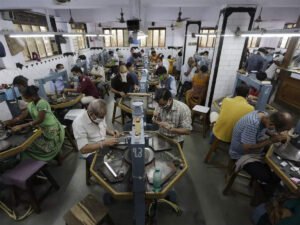Africa’s blood diamonds are infamous for their problematic mining and for fueling civil wars in the continent. However, Africa’s blood diamond has a lesser-known counterpart, the lab diamond. In her Budget speech today, Nirmala Sitharaman announced that the Government has suggested lowering the import duty on seeds used to create lab-grown diamonds. The goal of doing this is to increase domestic manufacturing.

Image Source: India Today
According to Sitharaman, India leads the world in the cutting and polishing natural diamonds, accounting for nearly three-fourths of the market’s value. She said, “With the depletion in deposits of natural diamonds, the industry is moving towards Lab Grown Diamonds (LGDs) and it holds huge promise. To seize this opportunity, I propose to reduce basic customs duty on seeds used in their manufacture.”
Moreover, Sitharaman also disclosed five-year research funding to the Indian Institutes of Technology (IITs) to increase the output of lab-grown diamonds. She said, “Lab-grown diamonds is a technology and innovation-driven energy-driven sector with high employment potential.”
So what are they? Scroll to know further!
The Diamonds:
Artificial diamonds, called lab-grown diamonds, are created in laboratories using cutting-edge technology under particular conditions. They resemble natural diamonds in their physical characteristics, chemical makeup, and visual properties. According to Mint, a microscope is required to differentiate between the two.

Workers Working In A Diamond Factory
Image Source: The Economic Times
This is carried out in Gujarat’s Surat, the nation’s diamond capital. According to CNBC, more than 400 factories are presently making lab-grown diamonds in the city of Surat. Additionally, lab-grown diamonds are between 40% and 70% less expensive than natural diamonds.
How are they made?
According to The Times of India, carbon seeds are placed in a microwave chamber to create lab-grown diamonds. These seeds are subsequently overheated into a bright plasma ball, a vital raw element used to create diamonds.
The process, which produces particles that crystallise into diamonds, takes weeks. Diamonds created in laboratories can be either chemical vapour decomposition (CVD) or high-pressure, high-temperature diamonds (HPHT). According to The Times of India, India is a world leader and a specialist in the former technology, which has been deemed to produce the purest kind of diamonds.

Lab Diamond-Making Machine
Image Source: Huanghe Whirlwind
The HPHT process, according to Indian Express, requires extraordinarily powerful presses to generate 730,000 psi of pressure at 1,500 °C temperatures. Graphite, utilised as the “diamond seed,” transforms into diamonds when exposed to these conditions.
CNBC claims that diamonds created in laboratories are utilised in computer chips, satellites, and 5G networks. This is because they can operate in hostile conditions and at higher speeds than silicon-based circuits while consuming less power.
What do the export numbers say?
According to the Gem and Jewellery Export Promotion Council (GJEPC), polished lab-grown diamond shipments from India grew by 70% to $622.7 million between April and July 2022, according to CNBC. According to a 2021 Mint report, India produced 1.5 million carats in 2020, less than China’s three million carat production in the same year.

Image Source: GJEPC
As the world’s traditional sources of rough diamonds face the prospect of deposit depletion, contributing to the exponential rise in the cost of extraction, these lab-grown diamonds have become a profitable alternative. Exporters of gems and jewellery have requested a reduction in the import tax on these seeds.
The Morale Booster!
The industry’s morale has been raised by the announcement of a reduction in import taxes on the raw materials used to make lab-grown diamond seeds. Vipul Shah, chairman of GJEPC, CNBC, reported, “We thank the Government for accepting its recommendation to promote indigenous manufacturing in the emerging Lab-Grown Diamond (LGD) sector by providing Research Grants to IIT for five years. GJEPC welcomes the reduction of Customs Duty on LGD seeds to zero from five per cent. It will ensure India’s end-to-end world leadership in rough-to-finished lab-grown diamond and jewellery manufacturing.”

Vipul Shah, GJEPC Chairman
Image Source: Jewellery Outlook
CRISIL, in a statement, said, “The grant provided to IIT for lab-grown diamonds is a positive. The segment has seen a steep 54 per cent growth in exports on-year, and accounted for 5 percent of total diamond exports YTD23.”
So what do you think about lab-grown diamonds? Do let us know in the comments!



















































































